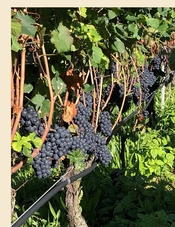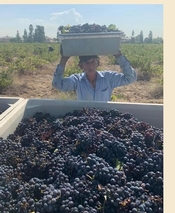Seasons. They come and they go, marking the time of the existence of the earth, bringing us a steady current of change and at the same time

bringing a consistent rhythm of life. Since ancient times, we have harnessed the physical seasons, planting in the spring and harvesting what each trip around the sun rewards our efforts with – sometimes defying expectations in spite of those efforts, sometimes to the good, sometimes to the tragic, and everything in between. This time of year, it’s good to be reminded, especially during what seem to be unending seasons of pandemic and political turmoil, that the physical seasons march on, and those that farm the fruit that becomes the beverage that we love are on the watch, monitoring what comes so that they can deliver the best of what the vintage has to offer.
I was in the local grocery store two weeks ago when my phone rang with a call from Christian Roguenant, a good friend and famed winemaker from California’s central coast. Roguenant began making wine in Burgundy, came to California to start a project with Deutz Champagne, moved on to Niven Family wines in Edna Valley, consulting with names like Alma Rosa and Rosenthal along the way. He’s currently with Lightpost Winery working with a varied menu that includes Pinot Noir, Chardonnay, Bordeaux and Rhône varieties as well as sparkling wine. With clear excitement in his voice, he proceeded to tell me that this, his 40th harvest, is the best that he’s ever seen.
Christian went on to say that while yields are lower, the fruit quality is unbelievably high, and that people should be preparing their wine budgets to pick up 2021 wines when they release down the road because they will hit that most desirable confluence – wines that are complex, pleasure driven and long lived. Then he hit me with the numbers that back the story up: A batch of Pinot Noir was picked at 25° brix with a pH of 3.2 and a TA of .9%. Wow!
If you’re not a person who gets worked up hearing these numbers, let me explain a bit. Brix is the amount of sugar in the grape at any given moment, which shows degrees of ripeness and indicates how much alcohol will result when fermenting to dryness. 25° brix is quite ripe – most wine grapes are picked between 19 and 25 degrees brix, sometimes even higher in New World winemaking. Fermenting to dry at 25° brix will result in around 15% alcohol.
Now, depending on your particular bent, you may be cheering that number, or it may make you nervous for the vintage. Your experience may tell you that high alcohol like 15% makes for wines that are bold, fat and on the perceptibly sweet side. Which can be true. Here’s where acidity comes to save the day.

The pH scale is one measure of acidity that winemakers look to as a picking indicator – it shows the relative acidity or alkalinity of a liquid. Most table wines have a pH between 3 and 3.6, with a few coming in over or under that range. For reference, water has a pH of 7 (neutral) and Coca Cola has a pH of 2.5 (bordering on corrosively acidic). Keep in mind that a pH of 3.2 is three times more acidic than a pH of 3.5. The TA, or total acidity is a volume measurement, where a higher number indicates more acid presence. Most wines come in at somewhere between .5% and .7% TA, with colder regions leaning to the high side, and warmer climates leaning toward the lower end of the range.
Here’s where it gets interesting. Typically, as grapes ripen, the sugar levels rise (the grapes get sweeter) and the acid levels fall. That’s why a bowl of grapes on the table is so attractive – it’s a sweet treat, right? Well, at 25° brix, in most years, acidity in the grape has already declined significantly. This can occur due to heat spikes and/or warmer overnight temperatures, while even seasons with cooler nights combined with more sun exposure help the grapes retain acidity as the sugar levels climb.
So what? Well, the numbers that Mr. Roguenant mentioned to me combined with the lower yields (fewer clusters per vine) indicate that the coming wines will show fruit forward ripeness and concentrated flavors balanced by racy acidity that keeps perceived sweetness at bay and in balance, allowing all that ripeness and concentration to be fully experienced. That acidic structure also adds stability to the wine, allowing it to age slowly and gracefully.
This piqued my curiosity, since, of course, the sugar and acid numbers will vary from microclimate to microclimate. I took a quick, totally unscientific survey of some winemakers to get their impression of 2021 from their unique perspectives. I’m fortunate to have a few of these folks on speed dial, and I’m happy to share their snapshots of the vintage.
Carol Shelton sources from all around the state, from Mendocino to Sonoma to Sierra Foothills to southern California, and she reports an earlier finish than prior years harvests by about two weeks, with a steady flow of fruit coming in from August 13th through October 6th. Drought and lack of irrigation water kept vine shoots short and berries small, which results in flavor concentration and lower yields. She’s also happy to report no fires or other mayhem in the mix.
Sierra Zeiter, who moved recently from Oak Farm in Lodi to Burgess Cellars in Napa Valley reports extremely low yields in Napa, but perfect quality, and predicts that the color depth and flavor complexity of the vintage will be memorable. Stu Smith of Smith-Madrone calls 2021 a high quality, no drama vintage after spending a few 2020 nights on Spring Mountain surrounded by the flames of the Glass Fire.
Rusty Folena of Vino Noceto in the Sierra Foothills says “painful” is the word in the region, with a lot of smoke and ash, but reports no smoke taint in the grapes, after finishing things up before October for only the third time in his 38 harvests. He says expect great quality and flavor, but expect a lower quantity as their Sangiovese haul was down about 30 percent.
Further south, Oceano Wines winemaker Marbue Marke is more than pleased with the great quality from Spanish Springs Vineyard in San Luis Obispo (a site also sourced by Lightpost Winery) saying, "I believe the quality for this vintage is going to be very good. It was an advantageous growing season from a style standpoint; you were able to get the flavors you wanted at a balance you wanted. So, you literally were picking the flavor target and the potential alcohol and acid balance fell perfectly in line. The yield was slightly below average in the Oceano blocks. This is in contrast to other parts of the North Coast like Napa, where some vineyards trended up to 30% down, so no real complaints. Berry size was slightly smaller than normal.”
Yet further south, Norm Yost of Flying Goat in Santa Rita Hills reports great color and concentration, with some area vineyards showing slightly lower yields. A cooling trend in late September/early October extended the hang time, and things are just wrapping up. Jim Hart of Hart Family Winery in Temecula and says it was a “decent harvest overall, no heat spikes so nice even ripening. Numbers have been phenomenal, (with) lower yields on everything so quality should be good. Good to have it all in the barn!” Winemaker Euan Parker said “This is my sixth harvest at (northern San Diego County’s) Fallbrook Winery. I thought 2020 was the best I’d seen, then 2021 went ‘hold my beer.’ Amazing season – clean, tasty, healthy grapes with ‘paint by numbers’ analytics on pH, TA, Brix and phenolics. Couldn’t be better!”
Finally, in contrast, a quick take on the other side of the country from Virginia’s Boxwood Estate Winery VP Sean Martin: “We had some challenges with both a hot season and rain at unfortunate and inappropriate times (including threat from a hurricane) and with this moisture and heat had high disease pressure from especially downy mildew. The Sauvignon Blanc and Sauvignon Gris came in very nice and clean. The reds, coming in later with more rain and disease pressure, were a little more challenging. But the vineyard crew did a good and thorough job of selecting fruit to send to the winery, and then with further sorting I think we are in good shape and have some good quality fermentations going on now!”
It's interesting to note that the domestic winemaking community has come a long way over the past fifty years, and even non-optimal situations can be mitigated. That said, ask any winemaker – the preferred vintage is one that they “just have to not screw up.” It sounds like California overall is positioned as such in 2021. For consumers, this means stashing some extra nickels for the 2021 wine releases down the road while continuing to enjoy the turning of the seasons and all that they have to offer.